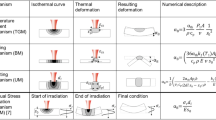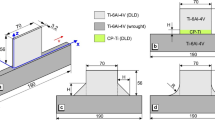Abstract
Cold forming generally allows the fast generation of parts with very low tolerances. In addition, mechanical properties are improved, if work hardening materials are used. Transferring the cold forming process to micro range leads to a decrease in the maximum achievable upset ratio so that the forming process becomes inefficient. Therefore, a laser-based free form heading process has been developed to generate preforms which can be calibrated in a secondary cold forming step. The achievable upset ratios reach values of several hundreds instead of 2.1 which is common for single step mechanical upsetting. In this article, heat losses arising in the material accumulation process using laser-based free form heading are analyzed and discussed. For this purpose, the process is modeled within the framework of continuum mechanics and simulated by a finite element method. By using a numerical approach, a systematic study on heat losses is performed in order to identify the influence of radiation, heat transfer due to convection and thermal conduction during laser irradiation time. The simulation results, which are validated with experimental data, show that the radiation is the most important mechanism reducing the efficiency of the accumulation process.












Similar content being viewed by others
References
Bristeau MO, Glowinski R, Periaux J (1987) Numerical methods for the Navier–Stokes equations. Application to the simulation of compressible and incompressible flows. Comput Phys Rep 6:73–188
Brüning H, Vollertsen F (2012) Self-aligning capability of laser based free form heading process. In: Proceedings of 11th international scientific conference MMA—advanced production technologies, pp 427–430
Bänsch E (2001) Finite element discretization of the Navier–Stokes equations with a free capillary surface. Numer Math 88(2):203–235
Bänsch E, Paul J, Schmidt A (2013) An ALE finite element method for a coupled Stefan problem and Navier–Stokes equations with free capillary surface. Int J Numer Methods Fluids 71:1282–1296
Dausinger F (1995) Strahlwerkzeug Laser: Energieeinkopplung und Prozesseffektivität. B. G. Teubner
Eichenhüller B, Engel U, Geiger M (2010) Microforming and investigation of parameter interactions. Prod Eng 4(2–3):135–140
Elliot CM (1981) On the finite element approximation of an elliptic variational inequality arising from an implicit time discretization of the Stefan problem. IMA J Numer Anal 1:115–125
Gale W, Totemeier T (2003) Smithells metals reference book. Elsevier Science, Amsterdam
Geiger M, Kleiner M, Eckstein R, Tiesler N, Engel U (2001) Microforming. CIRP Ann Manuf Technol 50(2):445–462
Jahn M, Luttmann A, Schmidt A (2012) A FEM simulation for solid-liquid-solid phase transitions during the production of micro-components. In: Proceedings of 11th international scientific conference MMA—advanced production technologies
Jahn M, Luttmann A, Schmidt A, Paul J (2012) Finite element methods for problems with solid-liquid-solid phase transitions and free melt surface. PAMM 12(1):403–404
Jahn M, Schmidt A (2012) Finite element simulation of a material accumulation process including phase transitions and a capillary surface. Tech. Rep. 12-03, ZeTeM, Bremen
Messner A (1998) Kaltmassivumformung metallischer Kleinstteile: Werkstoffverhalten, Wirkflächenreibung, Prozeßauslegung. Fertigungstechnik—Erlangen, Meisenbach
SA LM (2013) Stahl 1.4301. Tech. Rep. 2013/01, Lamineries MATTHEY SA, Lamineries MATTHEY SA, CH-2520 La Neuveville
Sakkiettibutra J, Vollertsen F (2009) Größeneffekte beim Stauchmechanismus am Beispiel geometrisch skalierter Brückenaktuatoren. Größeneinflüsse bei Fertigungsprozessen, BIAS Verlag, Bremen, pp 97–116
Stephen A, Brüning H, Vollertsen F (2011) Fokuslagensteuerung beim laserbasierten Stoffanhäufen. In: 5. Kolloquium Mikroproduktion und Abschlusskolloquium SFB 499, KIT Scientific Publishing, Karlsruhe, pp 155–160
Stephen A, Vollertsen F (2011) Influence of the rod diameter on the upset ratio in laser-based free form heading. Steel Research Int., Special Edition: 10th international conference on technology of plasticity (ICTP) pp 220–223
Vollertsen F (2013) Micro metal forming. Lecture notes in production engineering. Springer, London
Vollertsen F, Walther R (2008) Energy balance in laser based free form heading. CIRP Ann 57:291–294
Walther R (2009) An enhanced model for energy balance in laser-based free form heading. J Micromech Microeng 19:1–6
Acknowledgments
The authors gratefully acknowledge the financial support by the DFG (German Research Foundation) for the subproject A3 within the Collaborative Research Center (CRC) 747 “Mikrokaltumformen - Prozesse, Charakterisierung, Optimierung”. Further, we want to thank the AG Bänsch from the University of Erlangen-Nürnberg for cooperation.
Author information
Authors and Affiliations
Corresponding author
Rights and permissions
About this article
Cite this article
Jahn, M., Brüning, H., Schmidt, A. et al. Energy dissipation in laser-based free form heading: a numerical approach. Prod. Eng. Res. Devel. 8, 51–61 (2014). https://doi.org/10.1007/s11740-013-0509-8
Received:
Accepted:
Published:
Issue Date:
DOI: https://doi.org/10.1007/s11740-013-0509-8




